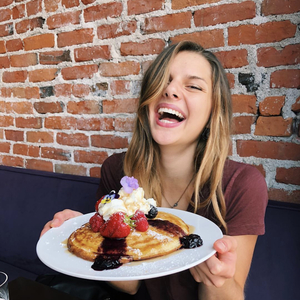It was lunchtime. I opened up my Vera Bradley lunchbox, one that was, at least on the exterior, nearly identical to every other girls’ lunchbox in my eighth-grade class. As I unpacked the sparse contents of my midday meal (a plain, grilled chicken breast and carrot sticks with hummus), I was filled with warring thoughts: on one hand, I was proud of myself for my discipline and commitment to eating a “healthy” lunch of wholesome foods instead of the processed fare of my classmates; but at the same time, an incessant part of me was aching for their brown sugar cinnamon pop tarts, their bagel sandwiches, and goldfish crackers. My stomach churned with hunger. I began to munch on my carrot sticks, trying desperately to drown out the noises of temptation.
I first began to pay more attention to my diet at the end of seventh grade, a time for many that is filled with friends, fun, and French fries. But my middle school experience was none of those things. I felt lonely. I felt powerless. So in attempts to cling to a sense of security, I found solace in controlling every morsel that went into my mouth.
In aiming for control, I was paradoxically becoming out-of-control.
According to all of the magazines and “fitspo” Instagram accounts that I was following at the time, I was perfectly healthy. I ate fruits, vegetables, and lean proteins. My exercise regime met all of the recommended areas, with dance classes four times a week to check off the cardio box, plus supplemental workout sessions at home to address strength training. I was following every single piece of advice I was given, crossing every t and dotting every i. But no matter how perfect my life appeared on paper, the real problem remained unsolved within myself. I was still lonely. I was still unhappy.
Because of my strict food rules, I further isolated myself from any social activity for fear that there would be food involved. Even a handful of buttered popcorn would ruin my day. The thought of eating a piece of greasy pizza was my worst nightmare. And forget about dessert all together; sugar was absolutely forbidden.
Unsurprisingly, I began to lose a lot of weight. My extra-slim jeans started to sag. Every time I brushed my hair, fistfuls of my once luscious locks fell out of my head. Sitting down at school was a new struggle, my tailbone protruding painfully into my chair as I found my spot in the room. But what I remember the most was the unshakeable cold, a sensation so deep that it seemed to make its way into the very marrow of my bones. I was a shell of my former self.
I think the most dangerous aspect of my eating disorder, which I now know to be orthorexia: the obsession with healthy eating, was that my harmful habits fell behind the guise of health. We are so accustomed to the messages telling us to eat less and exercise more, to skip dessert or face another round of exertion on the elliptical, that we are unfazed by the detrimental effect they can have on our physical and mental selves. Our bodies are not machines, and I think we’ve been tricked to think that happiness is the product of looking and eating a certain way.
Healing Took Time
In another four years or so, with the help of countless therapy sessions, support from my loving family, and many many many difficult days, I was finally able to start relinquishing my food rules. It began with eating that pizza that scared me to death and spooning my peanut butter onto my morning oatmeal without a tablespoon measurement. To be frank, I still have many days where I consider the “cleanliness” (whatever that means) of my meal before I consume it. I think that little nagging voice, to some extent, will always be there, telling me what’s good and bad for my health. But I think in focusing my energy on the benefits and joys of food, rather than its nutritional content, I may just be able to quiet the cries of diet culture to a barely discernible whisper. It’s going to take a whole lot of effort, but I’m up for the challenge.
If you or someone you know is struggling with an eating disorder, you can find resources online about how to help or how to screen yourself for an eating disorder. Let’s keep the conversation going.


